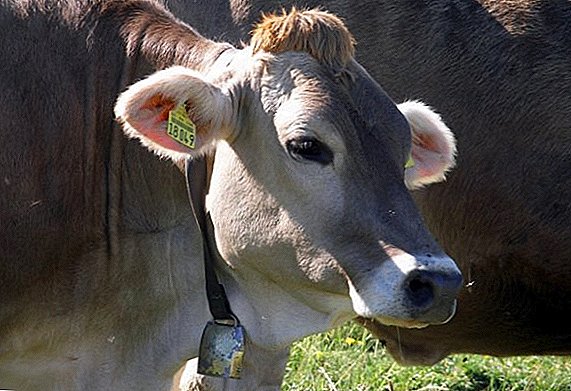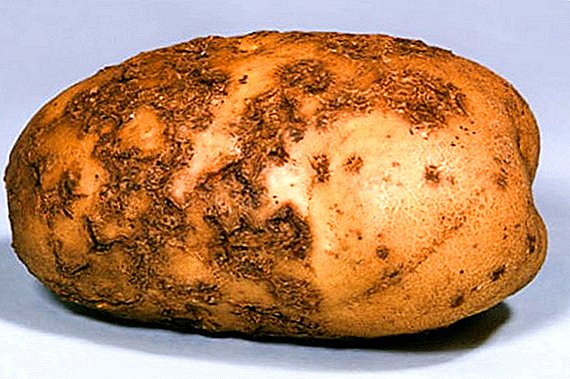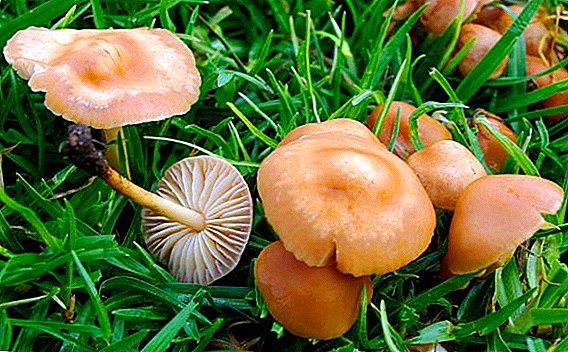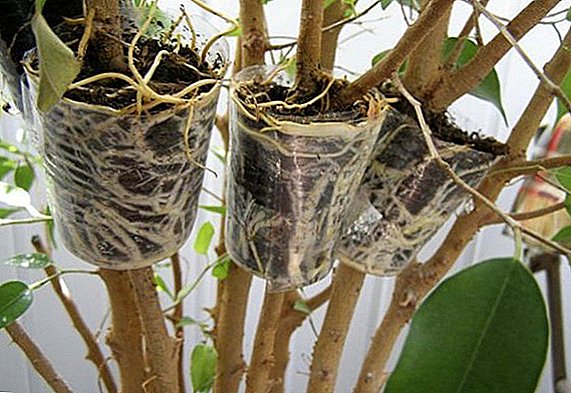 Ficus Benjamin attracts lovers of houseplants with its medium-sized foliage and spreading crown, and, like the rest of its relatives, it is distinguished by unpretentious nature and ease of maintenance. Let's look at how to propagate this plant at home, and what rules you need to follow.
Ficus Benjamin attracts lovers of houseplants with its medium-sized foliage and spreading crown, and, like the rest of its relatives, it is distinguished by unpretentious nature and ease of maintenance. Let's look at how to propagate this plant at home, and what rules you need to follow.
Ficus breeding methods
Ficus Benjamin multiplies mainly vegetatively, that is, a new plant is formed from a multicellular fragment of the parent organism. The following breeding methods exist:
- cuttings;
- layering;
- seeds.
Did you know? One of the species of ficus (Palmer) in nature grows on a cactus, gradually weaving it with its roots. To endure prolonged drought, it accumulates fluid and nutrients in a thickening at the base of the trunk, for which he received the name "Bottle" ficus.

How to propagate ficus cuttings
This is the most common breeding method. It does not require a lot of effort and time, but it is highly efficient. The method is quite accessible even to an inexperienced and novice gardener.
Optimal timing
It is best to engage in the breeding of Benjamin Ficus in the spring or early summer, when it is most actively growing. In addition, then young plants will have enough time to grow properly and get stronger before the cold season.
Ficus is in the 10-ke of useful indoor plants. In addition to it, useful properties are also highlighted: chlorophytum, aloe, geranium, laurel, Kalanchoe, chrysanthemum, cactus, pelargonium, sansevieria.
Proper preparation
From an adult parent plant, a stalk is cut to a length of 15 cm with a semi-woody base and 4-6 unfolded leaves. The milky juice released on the slice is removed with a soft cloth or cool running water. Low-lying leaves are cut off. Do not forget that all the cuts are made at an angle (obliquely). Usually for reproduction of ficus the apical part of the parent shoot is cut off. However, it is not necessary, the plant develops well even from a small stem stem with a leaflet. It is necessary only that one full-fledged kidney be in its bosom.  If it is necessary to propagate a plant from a part of a twisted branch, then it is necessary to cut its base several times with a knife along the stem. Then, make sure that the pieces do not touch by inserting a toothpick or match into the incisions. All this will stimulate the appearance of roots.
If it is necessary to propagate a plant from a part of a twisted branch, then it is necessary to cut its base several times with a knife along the stem. Then, make sure that the pieces do not touch by inserting a toothpick or match into the incisions. All this will stimulate the appearance of roots.
Important! Ficus has unique properties to clean its surrounding atmosphere. It intensively absorbs substances harmful to people - benzene, phenol, trichlorethylene and with the help of special enzymes converts them into amino acids and sugars.
Rooting cutting
The cuttings of this plant rooted in several ways:
- in water;
- in light and loose soil.
For rooting cuttings in the soil, you can take a mixture of peat land, river sand and crushed charcoal. You can also buy a substrate for growing ficus in a specialty store. The soil should be constantly wet, but not limp.  While maintaining a high humidity in the room and temperatures from +20 degrees Celsius, roots will form at the cutting for 2-3 weeks. To speed up this process, you can create a greenhouse effect, for which the container with the handle is covered with polyethylene or a glass jar. But do not forget to periodically remove it, so that the cuttings are aired.
While maintaining a high humidity in the room and temperatures from +20 degrees Celsius, roots will form at the cutting for 2-3 weeks. To speed up this process, you can create a greenhouse effect, for which the container with the handle is covered with polyethylene or a glass jar. But do not forget to periodically remove it, so that the cuttings are aired.
After the roots appear, the seedling can be planted in a permanent pot. Small cuttings are conveniently rooted in special pots for seedlings with a removable bottom, so it will be much easier to transplant later.
Planting seedlings
For planting a young plant, a well-aerated, moisture-permeable nutrient soil is required. You can purchase ready-made substrate for ficuses in a flower shop. Or make it yourself by mixing turf ground, peat and perlite. This soil contains the maximum of useful substances for the plant, which will allow the plant to gain a firm hold and develop quickly.  In the first few weeks it is better to cover the pot with a package and remove it when the ficus releases the first leaves.
In the first few weeks it is better to cover the pot with a package and remove it when the ficus releases the first leaves.
Important! Choose a warm and well-lit place for the plant, without drafts and direct sunlight. It is necessary to decide in advance on the location of the ficus, because he does not like to change places.
Features of reproduction ficus layering
An annular cut of the bark is made with a sharp knife on the trunk or a stiffened branch. It is important to cut carefully so as not to hurt the heartwood. The resulting free area is treated with a growth stimulator and turns into wet peat moss or soil mixture based on it. Then all this is fixed with a film and secured with thread, wire or tape.
When the roots become visible through the film, they are released, and the resulting seedling is cut below the roots and planted in a permanent place. Place the cut on the plant donor is treated with ground coal or garden pitch.  As a rule, this method is used by bonsai lovers in order to get a lot of aerial roots hanging from ficus. Or if the plant has few young shoots, but there are a lot of adult branches stiffened.
As a rule, this method is used by bonsai lovers in order to get a lot of aerial roots hanging from ficus. Or if the plant has few young shoots, but there are a lot of adult branches stiffened.
Is it possible to grow ficus from seed?
A rather rare way of breeding Benjamin is growing it from seed. This is a very time consuming and complex process and is hardly ever used in the home. The method is usually used to obtain new varieties and hybrids by professional breeders.
But if there is a desire to try, then before planting it is necessary to process the seeds with growth stimulants and fungicides, and then sow them superficially on a light and moist substrate. Then put the tank with seeds in a mini-teplichku, cover it with a film and wait for seedlings. Germination is possible while maintaining a temperature of + 25-30 degrees Celsius, good lighting and regular watering.
Did you know? A unique type of ficus - Bengali or banyan - can alone form a whole forest! On the large horizontal branches of an adult tree, aerial roots appear that descend, take root in the ground and form young trees. This ability banyan allowed him to be in the Guinness Book of Records.
Care for young plants
In order for a young sprout to take root well, be healthy and strong, you need to follow certain rules in the care:
- summer temperature + 25-28 degrees Celsius, winter - about +15 degrees;
- good diffused lighting without direct sunlight;
- regular watering without drying and over-wetting the soil;
- spraying the leaves and wiping them with a damp sponge;
- easy and nutritious soil with periodic top dressing;
- annual spring transfer of young specimens into a larger pot.












